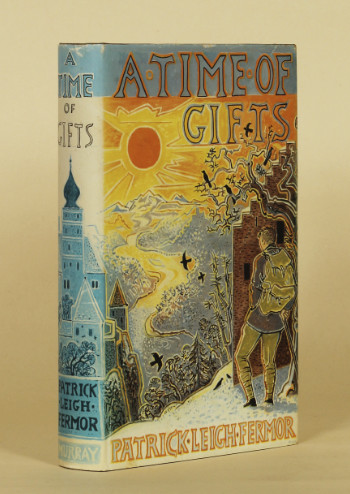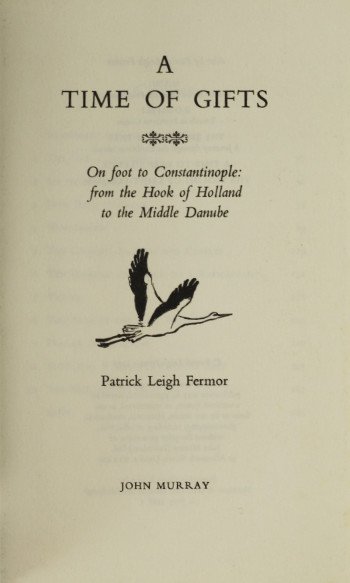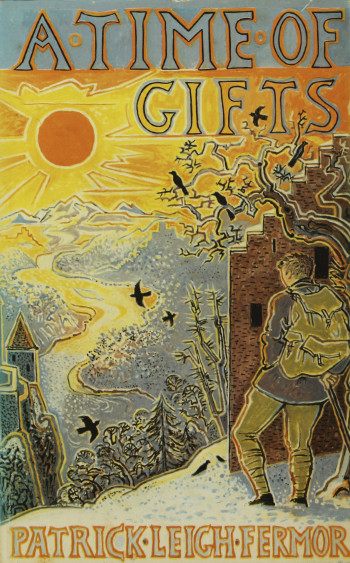THE FIRST VOLUME OF PATRICK LEIGH FERMOR’S CELEBRATED TRILOGY, RECOUNTING HIS JOURNEY ON FOOT ACROSS EUROPE FROM THE HOOK OF HOLLAND TO CONSTANTINOPLE
FERMOR, Sir Patrick Michael Leigh. A Time of Gifts. On Foot to Constantinople: From The Hook of Holland to the Middle Danube. London: Morrison & Gibb Ltd for John Murray, 1977.
Octavo (216 x 135mm), pp. [8 (half-title, image credit on verso, title, colophon on verso, contents, verso blank, epigraphs, verso blank)], 291, [1 (blank)], [4 (blank ll.)]. Half-tone portrait frontispiece after Valaşa Cantacuzène, one double-page map printed on light-brown paper. Title-vignette after John Craxton. (Occasional light spotting on margins, a few small marginal marks.) Original blue boards, decorated in gilt on the upper board with design after Craxton and titled in gilt on the spine, original pictorial dustwrapper after John Craxton, price-clipped. (Very light browning on endpapers, light spotting on edges, extremities slightly rubbed and faded, dustwrapper faded on spine, a few light marks, edges slightly creased and with short tear on lower panel.) A very good copy.

First edition. After he was expelled from the King’s School, Canterbury – whose headmaster believed that his student was ‘a dangerous mixture of sophistication and recklessness’ (quoted in A. Cooper, Patrick Leigh Fermor. An Adventure (London, 2012), p. 27) – Patrick Leigh Fermor (1915-2011) moved to London, to prepare for entrance into the Royal Military Academy, Sandhurst. In London Fermor lived in the Bohemian enclave of Mayfair’s Shepherd Market, where he moved in literary and artistic circles, and became disenchanted with the prospect of a career of peacetime soldiering. Instead, he determined in the winter of 1933 to undertake a journey across Europe, from the Hook of Holland to Constantinople, with the ambition of publishing an account of his experiences.
‘Leigh Fermor’s travels, which took more than a year, were (forty years later) to become the subject of his best-loved and most widely read books. He was crossing Europe on the tightest of budgets, collecting a few pound notes sent from home at various consulates and post offices as he went. Much of the time he was sleeping rough, in barns or hay-ricks or under the stars, and eating in whatever hostelry or inn he could afford. But he displayed an ability to make friends with tramps and simple fellow-travellers, who often made him their guest. As he progressed into Germany and Austria, following the route of the Danube, he acquired – almost by chance – introductions to a grander world of aristocrats who lived in sometimes decrepit and sometimes luxurious castles, who were charmed by his good looks, his intellectual curiosity, his latent erudition, and his good manners, and who passed him on to their friends; so he found himself sometimes sleeping alternately in cow-sheds and in four-poster beds. This enabled him to acquire – from the libraries and the conversations of his benefactors – a remarkable insight into the history and lifestyle of a fading world in a part of Europe which was just beginning to fall under the influence of Hitler and the Nazi movement. When he reached Constantinople, he did not tarry there, but visited the monasteries of Mount Athos in northern Greece, and then very briefly took part – joining some friends in a cavalry charge – on the royalist side in Greek internal uprisings. He then settled in Romania, having fallen in love with a local princess, the painter Balasha Cantacuzène […], sixteen years older than himself, with whom he lived for several years, to the dismay of his family’ (ODNB).

It was, however, only in the 1960s that Leigh Fermor began work in earnest on a book about his journey, and ‘[n]ow in his fifties, the older Paddy brought [to the book] the craft, broad learning, and experience of time passing that he could not possibly have had at eighteen; yet he never loses touch with the overflowing joy and curiosity of his younger self’ (Cooper, p. 350). This dual perspective presumably suggested the provisional title Parallax, but this was rejected (like the alternative A Winter Journey) in favour of A Time of Gifts, which was taken from Louis MacNeice’s poem ‘Twelfth Night’, and was ‘indefinite, a poetical quotation, susceptible to many interpretations, and all of them lucky and charming ones’, as Leigh Fermor wrote to his publisher Jock Murray (quoted in Cooper, p. 361). A Time of Gifts was published in September 1977 with a striking dustwrapper illustrated by John Craxton, and it enjoyed an immediate and wide success with both critics and readers, winning the W.H. Smith Literary Award. This first volume of the trilogy ends with Leigh Fermor standing on a bridge over the Danube, ‘meditatively poised in no man’s air’ between Czechoslovakia and Hungary (p. 277), finding it ‘impossible to tear myself from my station and plunge into Hungary. I feel the same disability now: a momentary reluctance to lay hands on this particular fragment of the future; not out of fear but because, within arm’s reach and still intact, this future seemed, and still seems, so full of promised marvels’ (p. 281).

A Time of Gifts was followed in 1986 by Between the Woods and the Water. On Foot to Constantinople from The Hook of Holland: The Middle Danube to the Iron Gates, but the final volume of the trilogy was not published in its author’s lifetime (The Broken Road. From the Iron Gates to Mount Athos was completed from Leigh Fermor’s papers by his literary executors Colin Thubron and Artemis Cooper, and published in 2013). This copy does not include the loose errata slip which is occasionally found in some (presumably later) copies. Due to its ephemeral nature, this slip is very rarely found with the book.
£95 – SOLD
· · · · · · · · · · · · · · · · · · · · · · · · · ·
Our Terms & Conditions apply.

